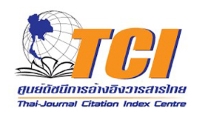JOURNAL DETAIL
Cold Pad-batch Dyeing Method for Cotton Fabric Dyeing with Uncaria Gambir Bark Using Ultrasonic Energy
Paper Type |
Contributed Paper |
Title |
Cold Pad-batch Dyeing Method for Cotton Fabric Dyeing with Uncaria Gambir Bark Using Ultrasonic Energy |
Author |
Walaikorn Nitayaphat* and Pornpen Morakotjinda |
Email |
walaikorn@g.swu.ac.th |
|
Abstract: Cold pad-batch method is relatively more environment friendly due to high dye fixation and non requirement of thermal energy. The dyed fabric production rate is low due to requirement of at least twelve hours batching time for dye fixation. The proposed cold pad-batch method for dyeing cotton involves ultrasonic energy resulting into 1 h in batching time. The dyeing of cotton fabric was carried out with natural dye extraction from uncaria gambir bark by conventional and ultrasonic method. The study showed that the use of ultrasonic energy can be useful in the reduced batching time. In this case, the color strength (K/S) and dye fixation (F%) also enhances without any adverse effect on color fastness of the dyed fabric. The ultrasonic method gives nearly the same color fastness properties as the conventional method. Further improvement in color fastness was observed with additional mordanting. |
|
Start & End Page |
1562 - 1569 |
Received Date |
2015-06-10 |
Revised Date |
|
Accepted Date |
2016-02-05 |
Full Text |
Download |
Keyword |
ultrasonic dyeing, cold pad batch, cotton, natural dye |
Volume |
Vol.44 No.4 (October 2017) |
DOI |
|
Citation |
Nitayaphat* W. and Morakotjinda P., Cold Pad-batch Dyeing Method for Cotton Fabric Dyeing with Uncaria Gambir Bark Using Ultrasonic Energy, Chiang Mai Journal of Science, 2017; 44(4): 1562-1569. |
| View:855 Download:490 | |
RELATED ARTICLE
Dyeing Characteristics and Performance of Natural Dye derived from Spent Coffee Ground on Cotton, Silk and Nylon Fabrics using Eco-friendly Dyeing Process
Article ID: e2025002
Author:Jantip Setthayanond, Porntip Tooptompong, Potjanart Suwanruji and Panticha Srisuwan
Vol.52 No.1 (January 2025) View: 1,519 Download:968
Article ID: e2025002
Author:Jantip Setthayanond, Porntip Tooptompong, Potjanart Suwanruji and Panticha Srisuwan
Vol.52 No.1 (January 2025) View: 1,519 Download:968
Kinetic and Thermodynamic Studies of Cationic and Anionic Surfactants Adsorption onto Polyethyleneimine-modified Cotton Cloths
page: 2422 - 2437
Author:Sorapong Janhom
Vol.45 No.6 (September 2018) View: 967 Download:434
page: 2422 - 2437
Author:Sorapong Janhom
Vol.45 No.6 (September 2018) View: 967 Download:434
Bifunctional Water-repellent and Flame-retardant Cotton Fabric Coated with Poly(methylhydrogen siloxane) and Ammonium Phosphate
page: 2211 - 2219
Author:Sunisa Jindasuwan, Mantana Suwan and Sitthisuntorn Supothina
Vol.45 No.5 (Special 2018) View: 897 Download:388
page: 2211 - 2219
Author:Sunisa Jindasuwan, Mantana Suwan and Sitthisuntorn Supothina
Vol.45 No.5 (Special 2018) View: 897 Download:388
Optimization of Dyeing Process Using Achillea pachycephala as a Natural Dye for Wool Fibers
page: 1548 - 1561
Author:Hossein Barani* and Kobra Rezaee
Vol.44 No.4 (October 2017) View: 916 Download:323
page: 1548 - 1561
Author:Hossein Barani* and Kobra Rezaee
Vol.44 No.4 (October 2017) View: 916 Download:323
An Evaluation of UV Protection Imparted by Wool Fabric Dyed with Natural Dye from Eucalyptus Leaf
page: 1208 - 1219
Author:Rattanaphol Mongkholrattanasit [a], Anothai Cholachatpinyo [b], Nitaya Tubtimthai [b] and Nattadon
Vol.41 No.5/2 (OCTOBER 2014) View: 859 Download:290
page: 1208 - 1219
Author:Rattanaphol Mongkholrattanasit [a], Anothai Cholachatpinyo [b], Nitaya Tubtimthai [b] and Nattadon
Vol.41 No.5/2 (OCTOBER 2014) View: 859 Download:290
Preparation, characterization, and antimicrobial activity of electrospun nanofibers from cotton waste fibers
page: 712 - 722
Author:Piyaporn Kampeerapappun*
Vol.39 No.4 (OCTOBER 2012) View: 835 Download:240
page: 712 - 722
Author:Piyaporn Kampeerapappun*
Vol.39 No.4 (OCTOBER 2012) View: 835 Download:240
Synthesis and Dye-fixing Properties of Copoly(CHDM-DM): Novel Useful Reactive Polycationic Dye-fixatives on Cotton Fabric
page: 587 - 598
Author:Yikai Yu* [a, b], Yuejun Zhang [b]
Vol.39 No.4 (OCTOBER 2012) View: 859 Download:239
page: 587 - 598
Author:Yikai Yu* [a, b], Yuejun Zhang [b]
Vol.39 No.4 (OCTOBER 2012) View: 859 Download:239
Effect of Chitosan and Mordants on Dyeability of Cotton Fabrics with Ruellia tuberosa Linn.
page: 95 - 104
Author:Piyaporn Kampeerapappun, Trongsu Phattararittigul, Sutida Jittrong and Dararat Kullachod
Vol.38 No.1 (JANUARY 2011) View: 957 Download:276
page: 95 - 104
Author:Piyaporn Kampeerapappun, Trongsu Phattararittigul, Sutida Jittrong and Dararat Kullachod
Vol.38 No.1 (JANUARY 2011) View: 957 Download:276
Isolation of Pigmented Microorganisms and Identification of Their Pigments
page: 1 - 8
Author:Siriwan Wichai [a], Supawadee Sriyam [b] and Suree Phutrakul [a]
Vol.28 No.1 (JUNE 2001) View: 889 Download:303
page: 1 - 8
Author:Siriwan Wichai [a], Supawadee Sriyam [b] and Suree Phutrakul [a]
Vol.28 No.1 (JUNE 2001) View: 889 Download:303
Copyrights © Since 2021 All Rights Reserved by Chiang Mai Journal of Science










